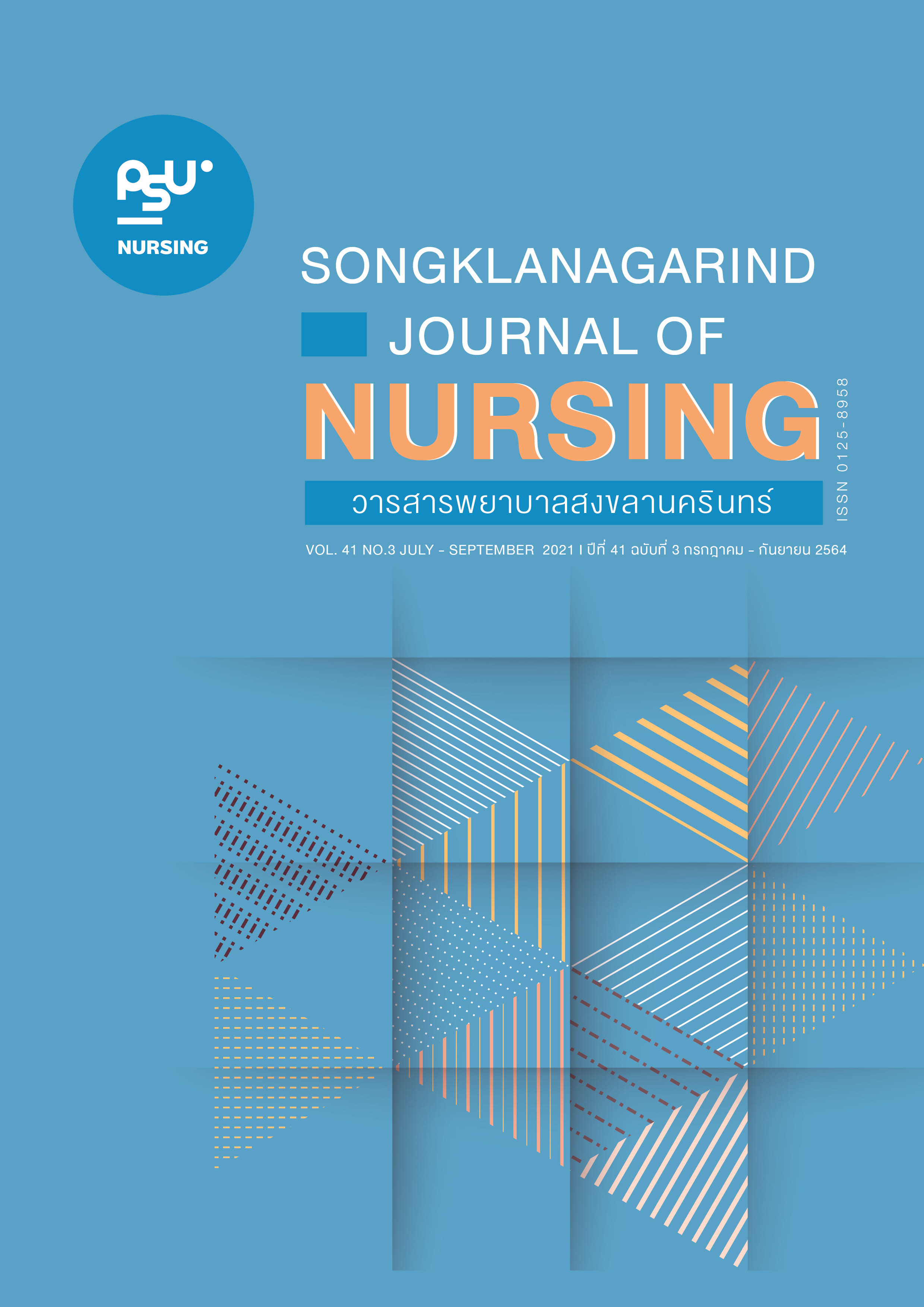ปัจจัยเสี่ยงต่อการเกิดภาวะกล้ามเนื้อหัวใจขาดเลือดเฉียบพลัน ในวัยผู้ใหญ่ตอนต้น: การทบทวนวรรณกรรมแบบบูรณาการ
Main Article Content
บทคัดย่อ
บทนำ: การทบทวนวรรณกรรมแบบบูรณาการนี้มีวัตถุประสงค์ เพื่อศึกษาปัจจัยเสี่ยงในผู้ป่วยวัยผู้ใหญ่ตอนต้นที่มีภาวะกล้ามเนื้อหัวใจขาดเลือดเฉียบพลัน สืบค้นงานวิจัยจากฐานข้อมูล CINAHL, PubMed, THAIJO, ProQuest, และ ScienceDirect ระหว่าง ปี พ.ศ. 2553-2563 หรือ ค.ศ. 2010-2020 ได้งานวิจัยฉบับสมบูรณ์ภาษาอังกฤษและภาษาไทยตรงตามเกณฑ์การคัดเข้า จำนวน 13 บทความ และทั้ง 13 บทความผ่านเกณฑ์ของสถาบันโจแอนนาบริกส์ ผลการสังเคราะห์การทบทวนวรรณกรรม พบการเกิดภาวะกล้ามเนื้อหัวใจขาดเลือดเฉียบพลันในวัยผู้ใหญ่ตอนต้นที่มีอายุระหว่าง 15-45 ปี ปัจจัยเสี่ยงที่พบแบ่งเป็น 2 ประเภท คือ (1) ปัจจัยที่ไม่สามารถปรับเปลี่ยนได้ ได้แก่ อายุ เพศ ประวัติของบุคคลในครอบครัวเป็นโรคหัวใจและหลอดเลือด และ (2) ปัจจัยที่สามารถปรับเปลี่ยนได้ ได้แก่ ภาวะไขมันในเลือดสูง ภาวะอ้วน ภาวะความดันโลหิตสูง เบาหวาน การสูบบุหรี่ การดื่มแอลกอฮอล์ การใช้สารเสพติด ได้แก่ แอมเฟตามีน กัญชา การไม่ออกกำลังกาย การรับประทานอาหารที่มีไขมันสูง การรับประทานผักผลไม้น้อย โฮโมชีสเทอีนในเลือดสูง และความเครียด สรุป: ผลการศึกษาครั้งนี้สามารถใช้เป็นข้อมูลพื้นฐานสำหรับบุคลากรด้านสุขภาพในการส่งเสริมสุขภาพเพื่อป้องกันปัจจัยเสี่ยงที่ทำให้เกิดภาวะกล้ามเนื้อหัวใจขาดเลือดเฉียบพลันในวัยผู้ใหญ่ตอนต้น และการวิจัยเพื่อศึกษาความสัมพันธ์ของปัจจัยดังกล่าวข้างต้นต่อการเกิดภาวะกล้ามเนื้อหัวใจขาดเลือดเฉียบพลันในวัยผู้ใหญ่ตอนต้นต่อไป
Article Details
เอกสารอ้างอิง
World Health Organization. World health statistics 2020: Monitoring health for the SDGs, sustainable development goals. Geneva: World Health; 2020.
Sricharan KN, Rajesh S, Rashmi, et al. Study of acute myocardial infarction in Young Adults: Risk factors,
presentation and angiographic findings. JCDR. 2012; 6(2): 257-60.
Strategy and Planning Division [Internet]. Bangkok: 2018 [cited 2020 Dec 15]. Available from: https://bps.moph.go.th/new_bps/.
Piromsit N, Srikulsiripanno J, Nurakhe A, et al. Factors influencing cardiovascular disease prevention behaviors among the risk group in SuphanBuri Province, Thailand. HCU JOURNAL 2018; 22(43-44): 55-69. Thai.
Chaiwong N, Bonkhonthod P. Factors preventive behaviors for coronary heart disease among persons at risk to disease. Journal of Nursing and Health Care. 2019; 37(2): 6-15. Thai.
Jamfa W, Chumpeeruang S, Rueangphut P, et al. Depression and quality of life among elderly living in Muang NakhonSawan Province. Boromarajonani College of Nursing, Uttaradit Journal. 2019; 11(2): 259-71. Thai.
Hat Yai Hospital Statistics Agency. (2017-2019). Statistics on Ward Accident and Hospital Emergency Hat Yai 2017-2019.
Mitsungnern T, Sukeepaisarncharoen W, Kiatchusakul S, et al. Acute myocardial infarction in the young age group patients in Srinagarind Hospital: A Descriptive Study. Srinagarind Med J. 2013; 28(3): 274-81. Thai.
Cheema FM, Cheema HM, Akram Z. Identification of risk factors of acute coronarysyndromein young patients between 18-40 years of age at a teaching hospital. Pak J Med Sci. 2020; 36(4): 821-24. doi: 10.12669/pjms.36.4.2302.
Kalimuddin M, Ahmed N, Badiuzzzaman M, et al. AMI in very young (aged ≤ 35 years) Bangladeshi patients: Risk factors & coronary angiographic profile. CTRSC. 2016; 13: 1-5. doi: http://dx.doi.ong/10.1016/j.ctrsc.2015.11.003.
Sricharan KN, Rajesh S, Rashmi, et al. Study of Acute Myocardial Infarction in Young Adults: Risk factors, presentation and angiographic findings. JCDR. 2012; 6(2): 257-60.
Dahal K, Karki P, Maskey R, et al. Risk factors of acute myocardial infarction in young adults of Nepalese population. IJMDC. 2018; 2(3): 80-5. doi: http://doi.org/10.24911/IJMDC.61-1529054592.
Deshmukh PP, Singh MM, Deshpande MA, et al. Clinical and angiographic profile of very young adults presenting with first acute myocardial infarction: Data from a tertiary care Center in Central India. Indian Heart J. 2019; 71(5): 418-21. doi: 10.1016/j.ihj.2019.12.004.
Sinha SK, Krishna V, Thakur R, et al. Acute myocardial infarction in very young adults: A clinical presentation, risk factors, hospital outcome index, and their angiographic characteristics in North India-AMIYA Study. ARYA Atheroscler. 2017; 13(2): 79-87.
Bhardwaj R, Kandoria A, Sharma R. Myocardial infarction in young adults-risk factors and pattern of coronary artery involvement. Niger Med J. 2014; 55(1): 44-7. doi: 10.4103/0300-1652.128161.
Sarr M, Ba DM, Ndiaye MB, et al. Acute coronary syndrome in young Sub-Saharan Africans: A prospective study of 21 cases. BMC Cardiovascular Disorders. 2013; 13(1): 113-8. doi: 10.1186/1471-2261-13-118.
Callachan EL, Alsheikh-Ali AA, Wallis LA. Analysis of risk factors, presentation, and in-hospital events of very young patients presenting with ST-elevation myocardial infarction. J Saudi Heart Assoc. 2017; 29(4): 270-5. doi: 10.1016/j.jsha.2017.01.004.
Wani MI, Rashid A, Beig JR, et al. Acute coronary syndrome (ACS) in the young: Angiographic features and risk factor analysis of patients with ACS before the Age of 35 Years. IJSS. 2017; 5(4): 244-8. doi: 10.17354/ijss/2017/373.
Tamrakar R, Bhatt YD, Kansakar S, et al. Acute myocardial infarction in young adults: Study of risk factors, angiographic features and clinical outcome. NHJ. 2013; 10(1): 12-6. doi: https://doi.org/10.3126/njh.v10i1.9740.
Haque A, Siddiqui A, Rahman S, et al. Acute coronary syndrome in the young-risk factors and angiographic pattern. Cardiovasc J. 2010; 2(2): 175-8. doi: https://doi.org/10.3329/cardio.v2i2.6635.
Balakrishnan VK, Chopra A, Muralidharan TR, et al. Clinical profile of acute coronarysyndrome among young adults. International. IJCCR. 2018; 4(1): 52-9.
Deora S, Kumar T, Ramalingam R, et al. Demographic and angiographic profile in premature cases of acute coronary syndrome: analysis of 820 young patients from South India. Cardiovasc Diagn Ther. 2016; 6(3): 193-8. doi: 10.21037/cdt.2016.03.05.
Pathak V, Ruhela M, Chadha N, et al. Risk factos, angiographic characterization and prognosis in young adults presented with acute coronary syndrome at a tertiary care center in North India. BMR Medicine. 2016; 3(60): 1-5.
Faisal AW, Ayub M, Waseem T, et al. Risk factors in young patients of Acute myocardial infarction. J Ayub Med Coll Abbottabad. 2011; 23(3): 10-3.
Mukherjee D, Hsu A, Moliterno DJ, et al. Risk factors for premature coronary artery disease and determinants of adverse outcomes after revascularization in patients ≤ 40 years old. Am J Cardiol. 2003; 92(12): 1465-7. doi: 10.1016/j.amjcard.2003.08.062.
Jamil G, Jamil M, Alkhazraji H, et al. Risk factor assessment of young patients with acute myocardial
infarction.Am J Cardiovasc Dis. 2013; 3(3): 170-4.
Daranisorn S, Boonchuang P, Pinyokun. Effects of transitional care program on health behaviors and functional capacity among acute coronary syndrome patients. Nursing J. 2013; 40(2): 103-12. Thai.
Phanthuwethy N, Absuwan N, Apinya T. Risk assessment and management manual cardiovascular disease. Nonthaburi: The Agricultural Cooperative Federation of Thailand Limited; 2014. Thai.
Draz EI, Oreby MM, Elaheikh EA, et al. Marijuana use in acute coronary syndromes. Am J Drug Alcohol
Abuse. 2017; 43(5): 576-82. doi: 10.1080/00952990.2016.1240800.
Neeraphattanakul S. Factors associated with acute coronary syndrome prevention behavior in diabetes and hypertension patients in Chonburi Province [master’s thesis].[Chonburi]: Burapha University; 2018. 92 p.


